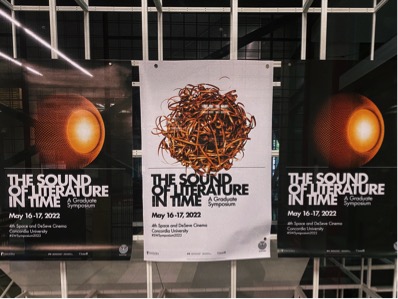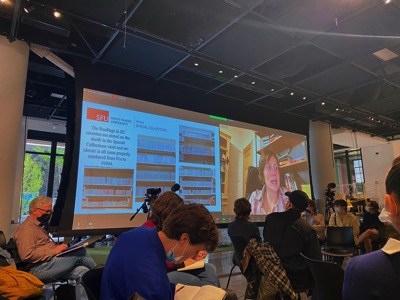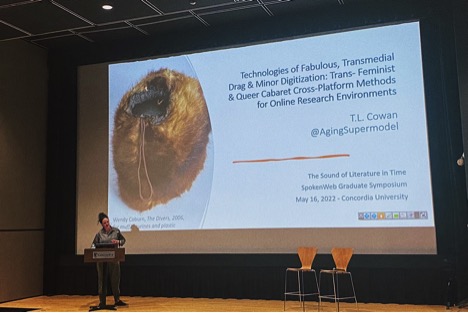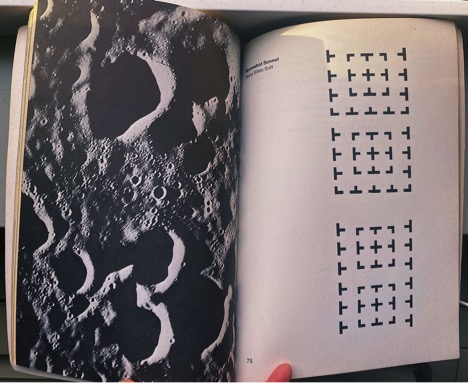Vibrate in Sympathy
A personal essay following SpokenWeb Symposium 2022: The Sound of Literature in Time
by Xiao Xuan Huang (SpokenWeb RA)

*
The SpokenWeb Symposium of 2022 begins with a plenary talk given by T.L. Cowan.
I slip into the auditorium a few minutes after the talk is scheduled to begin, which is a few minutes before the talk actually begins.
I’m sleep-deprived because of the previous conference – ACCUTE – where every night I somehow find myself by the Peel Basin with various groups of people (other conference attendees, some peers from UBCO, and one long-time friend who lives in Montreal,) staring at the moon glowing beside the FARINE FIVE ROSES sign.

*
The moon can be a symbol for nearly anything.
When explaining the name of his talk for the Third Annual Sharon Thesen Lecture in April, Poet Matthew Rader says, “So that’s the first part of the title of this lecture – Atmospheric Moon River. It’s a vibe. I’m not sure what it means, but I believe it is meaning-ful. That is my basic poetic stance: agnostic to a meaning, faithful to meaning.”[1]
The moon’s capaciousness – its ability to symbolize anything, and its meaningfulness – often allows it to stand in for what isn’t there.
(The words NO VACANCY is a double-negative, a friend points out, driving back from Alberta. That’s one way in which language elucidates vacancy’s fulsomeness, and vice versa.)

This feeling, or this moon mood, has structured my life. It made me not into a pessimist but a romantic; both are ways to cope with feeling like reality is majorly constituted by what’s missing,
and what’s missing is an excessive category.
*
Let’s just say (remainder)
the moon is a reminder a symbol for longing.
*
This year’s theme for the SpokenWeb Symposium is “The Sound of Literature in Time.”
The sound of literature has always in part been the sound of the ineffable. Stories and poems are always reaching into silence and absence.
There are numerous papers that take up the Symposium theme in their own ways, but a few voices continue resonating with me like the moon mood of longing.
(everything is capable of resonating,)
While resonance is a broad phenomenon, its preconditions remain particular.
*

Perhaps resonance is what I experience when I read Mary Ellen Solt’s “Moonshot Sonnet,” a poem which Kristen Smith says causes an “immediate stalling in the reading and sounding process.”[2] There is a phonetic refusal “even as the code is laid bare.”
The word code is often used to suggest that there is “a meaning,” to be deciphered. But what if we considered codes to be, like the moon itself, capaciously full of meaning – albeit produced through a hollow akin to NO VACANCY.
*
If Solt’s “Moonshot Sonnet” is an ineffable score that nonetheless remains maximally semiotic, then perhaps what it demonstrates is the unsounded hollow at the heart of all words, regardless of their being phonographic.
Hearing the not-quite-onomatopoeic use of the word “bells” that “carry on” throughout Edgar Allen Poe’s poem “The Bells,” Aubrey Grant also points out the sounding shape of vacancies and hollows, saying,
“repetition marks the contours of the empty place where it isn’t.”[3]
*
In Quotes: Transcriptions on Listening, Sound, Agency, the drag of experience happens in fragments – through broken down bits of conversation, entanglements, and interruptions.
As readers, we get to audit an experience of time and space (the SpokenWeb Conference of 2021, which itself virtually networked together participants and audiences from multiple places around the world,) through the interventions of the book’s co-curators – Klara du Plessis and Emma Telaro.

Speech is bridged into text aesthetically as well as associatively (it’s all done in stunning two-colour risograph printed by Vide Press,) which is why I read this publication as a poetic project.
*
This makes sense, as both curators engage intimately with poetics; Klara is a poet, and Emma’s graduate research focuses on the letter form of Diane Di Prima’s “Revolutionary Letters.”
I also read it as a piece of experimental criticism, which the publication explicitly calls forth as a space that is “slowly growing into a viable supplement to more traditional modes of scholarly input.”[4]
I feel at home in the SpokenWeb Network. I try all the time to articulate why, and maybe the most concise explanation is that it is, among other things, a place for experimental criticism.
When poetry is given a place at the table, it makes for more than just exciting research. It creates a vibe that might bring out more various amplitudes in our thinking; a vibe that can ride with you past an afternoon’s proceedings.
*
“I’m getting to work on the blog post. It’s an unexpectedly intense trip,” I say to Karis Shearer, principal investigator of the Audio Media Poetry Lab at UBCO, and one of the main people for whom I am writing this for.
I feel there are entanglements in my mess of notes I need to process for myself before I communicate them to others.

*
“Take your time,” she invites.
Take your time.
I’m struck by the generosity of these words in more ways than one. The most immediate of ways is that I, too, have said this to someone recently.
Some things are only possible if we take our time. In fact, it insists that we do.
*
In her presentation at the SpokenWeb Symposium,[5] Linara Kolosov speaks about the granular and iterative process of listening and re-listening to cassette tapes to create more than 2000 metadata entries in Simon Fraser University’s library archive, named Access to Memory.
Making sound last through time takes her and her research assistants literal years.

*
This is because sound often uniquely requires us to pay attention.
One thing at a time.
One sound at a time.
One person at a time.
Even and especially when the data is endless, and there are other sounds, other people in the room.
The investment is time, and there’s hardly a replacement for that.
Many of us feel how the demands of major literary, institutional, and social frameworks require us to expediate process (noun) as well as the way we process (verb.) This pressure extends into our emotional lives – or perhaps more accurately, this extends into things that we care about, things that hold incredible meaning and carry high stakes for us – and pushes us towards rendering them quickly (or ideally, all at once,) legible (to ourselves as well as to others.)
*
But more and more I think that the most efficient method is actually to take your time.
Because anything else would mean more mistakes, inconsistencies, starting over, loss of data, collapse of context, breach of privacy, or bad cataloguing.
If we care about these things at all, which is to say if we care about the subjects involved, then take our time we must.
*

Or, as T.L. would say –
*
“It’s about scale.
You can’t carry out Trans- Feminist Research Methods at a large scale.”[6]
Something about this plenary talk is moving me in my seat.
Maybe it’s because I’m coming down from watching the lunar eclipse the night before – beginning on May 15th and completing some time before 2:00 AM Eastern Time on May 16th.
The previous night’s events are clearly not over for me. I’m feeling the drag of this as I listen to T.L.
Her words provide something like a generous space or vessel inside which the experience of watching the eclipse with people I love is allowed to decant.
I feel an intimate resonance with her language – like something is happening not just in the words, over there, and in me, over here, but a certain energy, rising out from something like recognition or identification, shuttling back and forth between us.

It’s not unlike how good poetry makes me feel.
Not unlike it at all.
*
My dad, who is a physics teacher, likes to give me mini-lessons when we’re spending time together. From the back of a DiDi (Shanghai’s equivalent to Uber,) he points out these three bobblehead figurines that are stuck to the vehicle’s dashboard.[7]
“Everything has a natural frequency or vibration,” he says. “If you strike one of these bobbleheads and leave it alone on a stationary surface it might bob back and forth, say, once per second.
That’s its natural frequency. That’s the rate at which it likes to oscillate when free.”
I instantly love this language of preferences stemming from the universe.
“But in this scenario, the bobbleheads are being compelled to move at a different rate because it’s being affected by an ongoing, external driving force – that is, the movement of the car. The bobbleheads don’t get a chance to express its natural frequency. Instead, it might oscillate twice per second. Because the driving force overtakes the natural frequency. This is always true, as in, it’s a law of physics.
And yet – ” he emphasizes this next part, which tells me that he too hears a poetry in it, “the natural frequency is still there. It’s so innate that if an external driving force ever nears the natural frequency of an object, that object will begin vibrating at a much greater amplitude – a response known as resonance.
The severity of being exposed to a resonant frequency can be cataclysmic.
Resonance can, for example, be powerful enough to cause a bridge to collapse.”
*
There’s a temporal drag of three years between this conversation (originally taking place in 2019) and the 2022 SpokenWeb Symposium. When I get home after the symposium I look up the terms natural frequency and resonance once again. I get this definition:
“An object exposed to its resonant frequency will vibrate in sympathy with the sound.”[8]
I repeat this to myself like someone who just learned life-altering information –
will vibrate in sympathy with the sound,
will vibrate in sympathy with the sound.
*
Sitting on the floor at the back right corner of Penticton’s used bookstore days after the symposium, I pull at the sun-bleached pink spine of a volume called In and Out of Love.
In and Out of Love is an anthology of love poems published in 1971. It includes all the usual suspects: St. Vincent Millay, Pound, Dickinson, Byron, Shakespeare, Spenser etc. It’s supremely cheesy, yet I also find it impossibly compelling, because there are pictures (“arranged” scrapbook-like, by Bruce Vance,) as well as a few concrete poems inside.
This admixture of image and text asks us to read about love in more ways than one, recalling the hollow at the center of language.
I knew I had to buy the book ($4.00,) when I saw page 75:

Endnotes
[1] Matthew Rader, “Atmospheric Moon River: Poetics as Climate with Matt Rader,” Youtube, 2022, https://www.youtube.com/watch?v=nlYaYE1pjhA
[2] Kristen Smith, “Paper Description: Diagrammatic Codes, Lines, Crosshatchings: Finding Sound in Non-linguistic Poetry,” SpokenWeb Online, accessed July 11th, 2022, https://spokenweb.ca/symposia/#/spokenweb-symposium-2022.
[3] Aubrey Grant, “Resounding the Hollow: Repetition and Onomatopoeia in Poe’s ‘The Bells,’” (presentation, SpokenWeb Symposium, Montreal, Canada, May 16th, 2022).
[4] Klara Du Plessis and Emma Telaro, Quotes: Transcriptions on Listening, Sound, Agency, (Montreal: SpokenWeb, 2022), 13.
[5] Linara Kolosov, “Sixty years of Readings in BC: Access to Memory (AtoM) of the largest SFU sound collection,” (presentation, SpokenWeb Symposium, Montreal, Canada, May 16th, 2022).
[6] T.L. Cowan, “Technologies of Fabulous & Minor Digitization: Trans- Feminist & Queer Cabaret Cross-Platform Methods for Online Research Environments,” (plenary talk, SpokenWeb Symposium, Montreal, Canada, May 16th, 2022).
[7] What follows is a translation-reconstruction of our conversation, from Shanghainese-to-English, and from memory.
[8] Rob Landolfi, “How do you find an objects [sic] natural frequency?” Physics and Astronomy Online, accessed July 11th, 2022, https://www.physlink.com/education/askexperts/ae698.cfm.